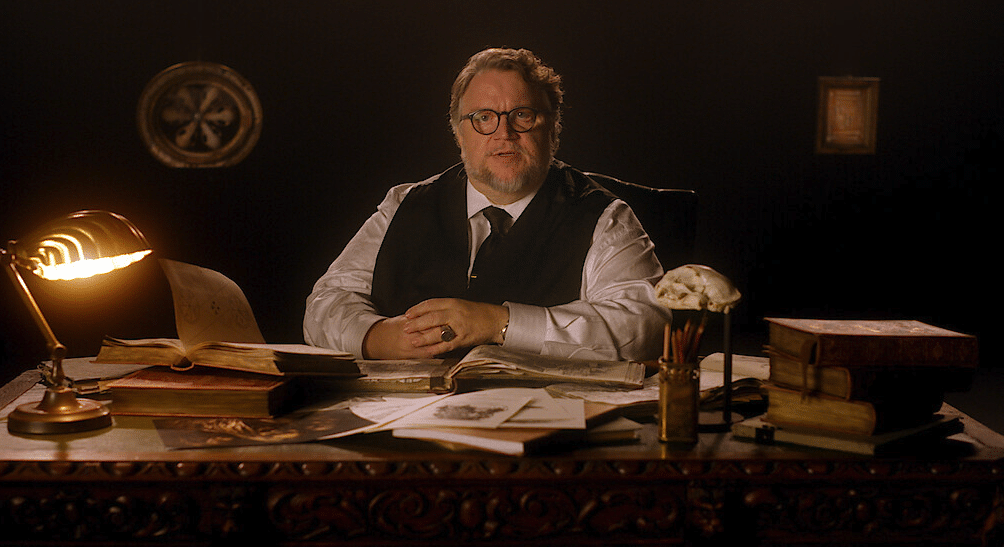The horror anthology is having a renaissance.
In the vein of Alfred Hitchcock Presents, beloved horror auteur Guillermo del Toro offers spooky shorts imprinted with his signature style in the new Netflix series, Cabinet of Curiosities.
The opening sequences are stunning: fans of del Toro will delight in the intricate machinery and grotesque monsters of the opening credits. The framing device of a wunderkammer, offering a small peek into a mysterious far-flung world, is delightful. It’s complemented by del Toro’s warm and effusive demeanour: his excitement at presenting each ‘curiosity’ is contagious.
Two episodes are out so far, with some interesting resonance between the twin tales – and perhaps a hint of narrative continuity? Each offers a cautionary fable of sinners whose greed leads to their doom. They lean toward cohesion rather than variation for now, so we’re left hoping the later episodes will flesh out the possibilities of short-format storytelling.
Read: Classic horror films and scary hidden gems streaming now
Horror anthologies offer some great solutions to common genre problems. There’s room for variety in tone. We get difficult protagonists who may or may not survive. The pacing is tight so the plots don’t lose their tension. There’s no time for exposition to diminish the mystery. Great actors can offer bombastic performances. All kinds of sub-genres can be explored: if one doesn’t thrill you then the next surely will.
Lot 36
The first tale, Lot 36, is directed by Guillermo Navarro, boasting a respectable history of prestigious TV and collaborations as del Toro’s cinematographer. It’s set in the midst of post-9/11 xenophobia.
This is a del Toro trademark: the sociopolitical backdrop deeply informs the supernatural themes of his stories without being heavy-handed. The lead for Lot 36 is Tim Blake Nelson, who normally has a magnetic presence but sadly underplays the camp possibilities for such a spooky tale. His Nick is a bigoted scavenger who buys abandoned storage lockers to fence their contents. Nick discovers the titular Lot 36, owned by a recently-deceased Nazi, is filled with demonic paraphernalia.
The occult rules are carefully set up for Nick to brazenly break them, but the social cues are a little more subtle. The cast is rounded out by an excellent ensemble: Demetrius Grosse and Elpidia Carillo bristle quietly at Nick’s barely-suppressed racism, creating a succinct but believable story arc as their relationships start to decay.
We’re primed for Nick’s pride to be his undoing, and it ultimately comes a little too slowly. Without wanting to give too much away, fans of Crimson Peak and Hellboy will be delighted by the slithering horrors that lurk beneath the surface of American manners.
Graveyard Rats
The second episode, Graveyard Rats, takes us further back in time to 1920s Boston. A crypt-keeper robs corpses of their valuables after he buries them. Like Nick in Lot 36, James Hewlett’s Masson is in debt to some nasty creditors and in bed with some nastier conspirators (a cameo from the menacing Julian Richings).
Unlike Nelson, Hewlett hams it up as the dastardly lead. His loquacious running commentary flows like Edgar Allen Poe (though the original story comes from Henry Kuttner, another American horror great). Masson is convinced the graveyard rats are stealing entire corpses, and even as his fellow vermin start plaguing his nightmares, he can’t resist the bounty of the gold-toothed corpse he’s just interred.
This one comes from Vincenzo Natali, a cult horror director with a distinctive visual style. While the monsters of this episode aren’t quite as thrilling as Lot 36, Natali’s sets have the striking texture of a modernist painting. If other directors chase the golden hour, Natali has a particular affinity for a silver hour that casts an eerie pallor over his work.
As the tale grows claustrophobic, Hewlett’s monologues crowd the space even more: one fears he will surely run out of air as he eloquently pleads for his life in the catacombs.
Read: Laurie Strode and the legacy of the final girl
Keep your eyes peeled for some hilarious captions: whoever works on Netflix’s horror shows is as articulate as Hewlett in describing the squelching soundscape. Like Lot 36, the climactic scenes are a bit too prolonged: the advantage of an anthology is there’s no need to waste time on the big set pieces. Tighter pacing would keep the blood pumping fast as we thrill at the temporary protagonists’ time running out.
Both Lot 36 and Graveyard Rats feature greedy villains robbing the dead, hunted by emaciated corpses in the tunnels of lost history. At this stage, it’s not clear if the visual similarities are going to unify the whole collection with an especially malevolent beastie, or if Natali and Navarro are paying homage to del Toro’s distinctive creature features.
The two episodes offer a classic theme with plenty of potential, but it does leave one hoping that the remaining six tales will offer a bit more curiosity.
Guillermo del Toro’s Cabinet of Curiosities is currently streaming on Netflix.
Actors:
Director:
Format: Movie
Country:
Release:





